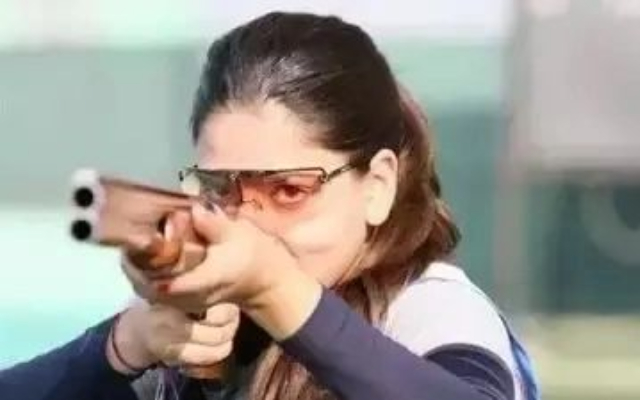
Born into a legacy of precision and excellence, Rajeshwari Kumari—daughter of Olympic-level trap and skeet shooter Raja Randhir Singh—is carving out her own unique path. Not only is she making her mark in the shooting world, but she’s also turning heads in the fashion industry. In an exclusive conversation with Revsportz, Rajeshwari opens up about balancing her dual passions, the influence of her parents, and how she’s gearing up for the upcoming ISSF Shotgun World Cup.
Q: To start off, how do you manage to juggle two completely different career paths—shooting and fashion—and excel in both?
Ans: I have a good partner and I have good support at home and whenever I am travelling for my sporting events, they handle everything.
Q: Coming from a family with a rich legacy in shooting—your father inspired by his aunt, and now you, an Asian Games medallist and Olympian—how instrumental has your father been in shaping your career?
Ans: My father—he’s a six-time Olympian, won India’s first shooting gold medal at the Asian Games—and I was the youngest child, so I always felt this responsibility of carrying on the legacy. He has been my biggest mentor. It’s amazing to have someone like that at home, someone you look up to, who’s so disciplined, who knows exactly what he wants to do, and how to help others through sport. Just the way he’s been—both as an athlete and as an administrator—it’s been a real privilege to have grown up around that.
So yes, he’s been the inspiration right from the beginning of my career till now. But honestly, my mother has been the one who’s been really involved on a daily basis. She’s the one who used to kick me out of bed as a kid, saying, “Go, do something! You’ve got so much to live up to—with this whole legacy from your ancestors.” She’s the one who’s been pushing me to keep going.
My dad, on the other hand, has always been more chill. He’s like, “It’s okay, baby. Just do whatever you want to do. Don’t stress.” As a kid, shotguns used to scare me, but it slowly started to build up on me. It was like, “Oh my father did it”. So, like every kid, I was like, I wanted to do
What my father did.
Q: The Paris Olympics didn’t turn out the way you had hoped. What was the aftermath like for you, and how did you find the motivation to bounce back, refocus, and continue pushing forward to represent the country?
Ans: Luckily, in our country, you don’t really get much of a break where you’re allowed to sit and ponder over something—even something as big as the Olympics. You have to get on with it. You have to wake up the next day and get back on deck. You had a bad day, and now the next one is coming.
So I went straight from that to a World Cup Final, where I was injured—and that turned out to be an even bigger disaster. I did go into a bit of a rut, but slowly, slowly, you get out of it. There is this post-Olympic depression sort of thing that happens to you. But it was my first Olympics, so I felt like I wasn’t actually that bad after it.
Q: How are your preparations coming along for the upcoming World Cup in Cyprus?
Ans: It’s been like one day at a time. Once you come through such a high-pressure event like the Olympics, I think you start counting your blessings in small, small things and look at smaller competitions where you’re like… even in the selection, everything that used to feel so big earlier, now you’re a lot more like, “Let me change this aspect and then try and do this.” So I’ve just been working on it one day at a time—like a one-step-at-a-time approach towards the World Cup. Of course, I have confidence. But I don’t usually talk about all of that before I actually go out and do the work. I’m a bit superstitious that way.
Q: Has it become easier for others to come through the ranks and compete in this sport? And what has the support from the Reliance Foundation and the government been like for you?
Ans: I knew about it (shooting) because of my father, but now I think they’ve (other women players) really started picking up on this sport as well. Ever since that Olympic medal win, it has picked up a lot. When I started—and I started late, at 20—there were just two squads of women, about 12 shooters.
Now, there are hundreds. So, it’s definitely growing. Reliance Foundation and companies like that have been really helpful, especially for the younger players. The kind of backup and support they offer—you know, that feeling of “you go do your thing, we’ve got everything else covered”—that makes a big difference. When I started, I was the one figuring out what kind of nutritionist or trainer I should get. But now, everything is taken care of. It allows you to focus solely on your performance, knowing there’s a solid system backing you. And it’s the same for other youngsters too—that’s how welcoming the system has become now. Even academies like the one in Madhya Pradesh have made a huge impact. We’ve seen a lot of talented young girls come up through that setup. So yes, these academies and foundations are really doing a lot to support upcoming athletes.
As for the Indian government, there’s definitely been a huge improvement. The federation and the government have really stepped up. There’s this constant support—you get everything you need. The TOPS (Target Olympic Podium Scheme) has been a big part of that. Even I’ve benefited from it, and
they’re so involved now, which really makes a difference.
Q: Recently, the IOC announced changes for the Los Angeles 2028 Games, including increasing the number of finalists in rapid-fire pistol and shotgun events from six to eight, and replacing the mixed skeet team event with the mixed trap team competition. What are your thoughts on these changes, and how do you see them impacting the sport?
Ans: They want to see more countries in the finals and want to give everybody a fairer chance—because with so many shooters competing, sticking to just the top six is also a bit unfair. So, I think it will be a nice and interesting change to see.
And they are also alternating the team competitions between Olympics. So, with the mixed skeet team being replaced by the mixed trap team, that adds another medal opportunity. First, another qualification spot, and then potentially another medal for India—which can definitely be a positive.
Q: Have you been following the ongoing World Cup, first in Argentina and now starting in Peru?
Ans: We’re all very close in the shooting team, at least in the short events, like family. Since we’re travelling together for weeks at a time, it’s usually just us with each other. I haven’t been in touch with them right now, but I don’t want to disturb them while they’re focused. Once we’re all together again, we’ll talk about it.
As for training, it usually starts before the event. You get a warm-up session or something to prepare. There’s also a coaching round that typically happens a week before the competition.
I wish the very best for the upcoming World Cup, and I hope to make India proud once again, just as I always strive to do on the field.
Follow Revsportz for more sports related news



